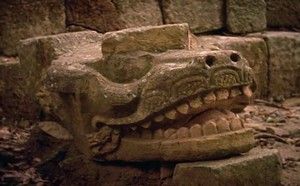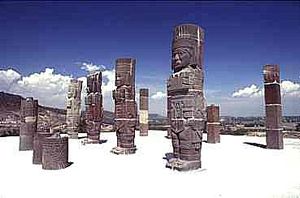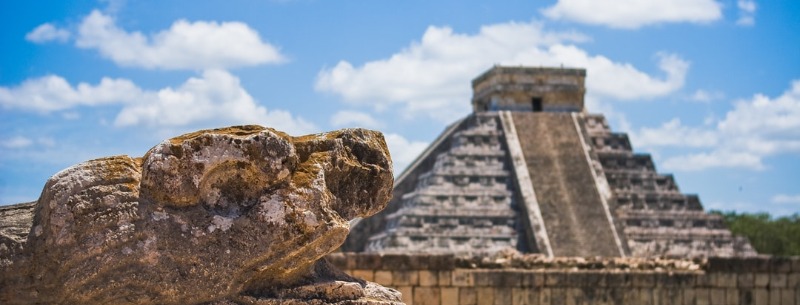Chichen Itza, about 4 hours from Cancun, was abandoned long before Columbus reached the “New World”, yet Maya culture continues to exert a significant influence today in the lives of millions. During the “Dark Ages” of Europe, the Maya of Chichen Itza had sophisticated mathematics and astronomy, and the only written language in the Americas.
Maya civilization and culture spread from its origins on the Yucatan peninsula to much of Central America, where it still thrives in the lives of 5 million people, more than 30 languages and many ethnic backgrounds. Modern Maya continues many of their ancient traditions such as speaking Indian dialects instead of Spanish. Many spiritual aspects of Mayan life are still exercised today, fusing Catholicism with Mayan beliefs.
Circa 550 AD, Mayas settled Chichen Itza around two wells; one sacred and one profane (for everyday use). These underground wells and connecting waterways, known as “Cenotes”, were believed to be doorways to the “Afterlife”. Many scuba divers, today, enjoy exploring these clear underground rivers.
Chichen Itza, like most Mayan ruins, was primarily a spiritual and ceremonial site, with its ballgames and human sacrifices. According to Toltec history, in 987AD the legendary ruler Quetzalcoatl was defeated and expelled from Tula. He was last seen leaving from the Gulf coast on a raft of serpents. In the same year, Mayan stories recorded the arrival of a king named Kukulcan, the Serpent God, whose return had been expected. Kukulcan defeated the Mayan city tribes and made Chichen Itza his capital. In the spring and autumn equinoxes, the sun’s shadow on the steps of Kukulkan’s pyramid creates the illusion of a snake (Quetzalcoatl) moving to earth.
El Castillo
The main structure at Chichen Itza
The largest, and most impressive, structure at Chichen Itza is El Castillo (The Castle, in Spanish). It is a step pyramid and stands nearly 100 feet tall. El Castillo is the temple for the Mayan god, Kukulcan.
It used to be open to the public for climbing, but to preserve it and for the safety of the tourists, it has been closed down. This is unfortunate for those that never got to climb it, but you have to agree with the decision to preserve it for future generations
Something interesting about El Castillo is that on the spring and fall equinoxes, the sun hits the structure in such a way as to cause shadows on the sides of the pyramid that look like serpents. This event is believed to have been of great religious significance to the Mayan civilization.
In 2007, El Castillo was voted as one of the Seven Wonders of the World. It joins the Great Wall of China, the Taj Mahal, the Great Pyramid of Egypt, and others.
The Observatory
The Mayan Observatory at Chichen Itza
Another one of the prominent and interesting structures at Chichen Itza is the Observatory. The Observatory, called El Caracol (translates to ‘the snail’), was the place where the Ancient Mayans observed the cosmos and participated in religious rituals.
The Ancient Mayans developed an amazingly accurate (yet complex) calendar and were extremely advanced in such things for that time period. They were able to record and predict such events as eclipses. The observatory was where this took place at Chichen Itza.
Chichen Itza Tours
For hundreds of years, people have been fascinated by Chichen Itza. If you can only do one day trip during your Cancun vacation, make it Chichen Itza. A three-hour journey takes you to the most breathtaking Maya ruins in the world, with a stop in the Spanish colonial town of Valladolid along the way. Climbing the famous pyramid known as El Castillo will provide you with breathtaking views of the surrounding miles of lush jungle and what was once a thriving city over a thousand years ago.
Chichen Itza hosts one of the world’s most famous natural phenomena twice a year. The sun is in exactly the right position during the Autumn Solstice and Spring Equinox to cast a shadow that resembles a snake descending to the ground. This is recreated nightly after dusk in the incredible sound and light show. A special headset allows you to listen to the night show commentary in several languages.
The famous Chac Mool sculpture and the Jaguar Throne can be found inside the Mayan pyramid. El Castillo, however, is not the only interesting feature at Chichen Itza. Other spectacular scenes from a long-forgotten world include the Mayan Ballpark, with its unique echoes, the Temple of the Warriors, the Cenote of Sacrifice, and the Observatory.
Be aware that Chichen Itza is located far inland, and the temperature will be significantly higher than at your beachside hotel. Bring plenty of water and sturdy footwear. Pay attention to the warning signs. The ascent inside the pyramid to see Chac Mool’s statue and the Temple of the Jaguars is also extremely steep, claustrophobic, and extremely hot and humid. The ascent of the pyramid is not for the faint of heart or those who are afraid of heights.
A typical Mayan village is a short walk away from the main Chichen Itza complex. There are some very inexpensive restaurants here; why not stop for an authentic Yucatan meal? You may come across street vendors, many of whom are barely old enough to speak. A simple “No Gracias” with a smile will send them on their way, but the handicrafts they sell (often made by their own mothers and fathers) are genuine and inexpensive.
Getting to Chichen Itza
How to get to Chichen Itza
Chichen Itza is about a 2-hour drive from Cancun, and trips are made daily by several tours. On the trip I went on, we left Cancun at 9:00 in the morning, stopped at a very nice Mexican buffet for lunch, and made it to Chichen Itza by about 1:00. I, along with family, explored the place and we stayed until about 6:00 pm.
Getting to Chichen Itza is pretty painless, and every hotel has some kind of tour package or arrangements for going there. Chichen Itza is such a prominent tour destination, and if you go out shopping, you’ll probably be confronted with people trying to sell you tours to it or another Mayan ruin.
I think it’s best and safest to talk to the hotel and book a tour through them. Otherwise, there are places like Cancun Travel that are good to book through. When booking, make sure some kind of food stop is included, as well as a tour guide is included. My tour guide had some interesting information and stories to tell, and he was also of Mayan descent and could speak the Maya language. It was cool.
There is also the alternative of driving to Chichen Itza yourself. I, personally, wouldn’t do it because it’s a hassle going through the checkpoints and stuff, plus I’m bad with directions. I remember going through at least 3 checkpoints and toll stations, so there’s something else to worry about. Tour packages have that all included and taken care of, so I prefer that route.
Tips For a Good Tour to Chichen Itza
- Some more tips for a good time at Chichen Itza
- Book your tour through someplace trustworthy, such as your hotel or Cancun Travel.
- Make sure a food stop is included, as well as a tour guide if you don’t want to explore by yourself.
- Be sure to take a lot of water to Chichen Itza. The jungle gets very hot and steamy. However, there are vendors there selling drinks such as Gatorade and soda pop.
- Take some money to buy things. There are vendors galore at Chichen Itza selling t-shirts, Mayan souvenirs, and much more.
- Related to the tip above, don’t pay the prices vendors are asking. They are usually quite expensive, and the price can be brought down a LOT.
- Learn some Mayan history before you go. It will make the trip so much more enjoyable.
- Take bug repellent. The rainforest can be vicious.
- No video cameras, unless you want to pay a $25 federal fee. Pictures only!
- Be safe, smart, and have a good time!
Mayan Ruins
Mayan Ruins extend from the Yucatan peninsula to El Salvador, covering 5 Latin American countries and an area far greater than the Aztec empire. Long forgotten and shrouded in jungle, Mayan ruins are still being discovered today.
 Around 2,000 BC the Mayas emerged from the Mexican Yucatan spreading a culture of advanced architecture and astronomy. Believing themselves made from corn (maize), they created a pantheon of gods to govern the cycles of seedtime and harvest.
Around 2,000 BC the Mayas emerged from the Mexican Yucatan spreading a culture of advanced architecture and astronomy. Believing themselves made from corn (maize), they created a pantheon of gods to govern the cycles of seedtime and harvest.
With the beginnings of agriculture, the Mayas turned from hunting and gathering to constructing temples and highways and building great cosmopolitan centers. The classic Mayan period from 300 to 900 gave rise to Tikal, Copan, Coba, and Palenque with steep stepped, platformed pyramids, arranged around elaborately designed courtyards. These ruins are the most elaborately built and best-preserved of pre-Columbian structures.
Constructions of the late classic period find the introduction of ornate, carved, inlaid building stones. By 900 all of the classic sites of the Southern Mayas had been abandoned, and monument building came to a halt.
Chichen Itza in the north, however, flourished for another 300 years, until its abandonment around 1200. At about the time of Chichen Itza’s demise, a militaristic alliance of several cities known as “Mayapan” became the dominant force in the Yucatan; building walled cities and subjugating large portions of the region. Their architecture consisted primarily of fortresses.
A rebellion led by Uxmal overthrew the Mayapan alliance around 1400. and destroyed their cities. The Conquistadors’ arrival in 1516 found Tulum, on the Caribbean coast, to be the last remaining Mayan city.
Tula Mexico
Tula Mexico (map) “Where The Language Changes” was the capital of the Toltec Indian empire. Tula is located in an arid region of the Valley of Mexico where little can be grown except the Maguey cactus (the basis of alcoholic “Pulque”) which formed a significant part of their religion.
 Legend has their high priest Quetzalcoatl banished to the east after a drunken orgy. A lesson on the sins of “John Barleycorn” may be inferred here. The city rose to power after the collapse of Teotihuacan, taking control of the Valley of Mexico around 968 AD, and forming an important link in the chain of Meso-American civilization.
Legend has their high priest Quetzalcoatl banished to the east after a drunken orgy. A lesson on the sins of “John Barleycorn” may be inferred here. The city rose to power after the collapse of Teotihuacan, taking control of the Valley of Mexico around 968 AD, and forming an important link in the chain of Meso-American civilization.
The site is now known primarily for its main pyramid, on whose top stand the 15 foot high stone Toltec warrior gods. Attaining a population of 50,000; the site was abandoned around 1200ad, possibly due to famine.
The Toltecs appear to have re-surfaced later in Chichen Itza on the Yucatan peninsula with their recognizable architecture and snake worship.
